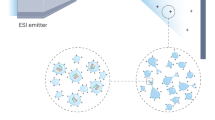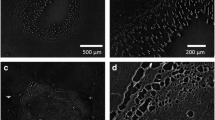Abstract
The comparison between electrospray ionization (ESI) mass spectra from NaCl solutions with and without analyte obtained under ionspray and nanospray conditions reveals different mass spectral behavior of the two ESI techniques. This can be attributed to the different initial droplet sizes which are in the µm range for ionspray, while in nanospray they are believed to be about one order of magnitude smaller. In the context of the widely accepted uneven-fission model, nanospray would then enter one fission generation later; in addition, a higher initial droplet surface charge density in nanospray results in early fissions without extensive evaporation and thus increase in sample and salt concentration. This rationalizes that ionspray spectra closely resemble nanospray spectra from solutions with about one order of magnitude higher salt concentrations, showing a higher tolerance of nanospray towards salt contamination. When the analyte is a peptide (in a solution containing a high molar surplus of salt), molecule ion formation effectively competes with salt cluster ion formation; when the analyte is a sugar, it is detectable beside a high salt concentration only with nanospray, indicating the supporting effect of surface activity on ion release in the case of peptides. A model is presented which explains the different mass spectral behaviour of ionspray and nanospray by suggesting different “predominant fission pathways” depending on the size of the initial droplets.
Similar content being viewed by others
References
Kebarle, P.; Tang, L. Anal. Chem. 1993, 65, 972A-986A.
Iribarne, J. V.; Thomson, B. A. J. Chem. Phys. 1976, 64, 2287–2294.
Thomson, B. A.; Iribarne, J. V. J. Chem. Phys. 1979, 71, 4451–4463.
Meng, C. K.; Mann, M.; Fenn, J. B. Z. Phys. D 1988, 10, 361–368.
Nohmi, T.; Fenn, J. B. J. Am. Chem. Soc. 1992, 114, 3241–3246.
Fenn, J. B. J. Am. Soc. Mass Spectrom. 1993, 4, 524–535.
Ikonomou, M. G.; Blades, A. T.; Kebarle, P. Anal. Chem. 1989, 63, 1989–1998.
Tang, L.; Kebarle, P. Anal. Chem. 1993, 65, 3654–3668.
Sakairi, M.; Yergey, A. L.; Siu, K. W. M.; LeBlanc, J. C. Y.; Guevremont, R.; Berman, S. S. Anal. Chem. 1991, 63, 1488–1490.
Guevremont, R.; Siu, K. W. M.; LeBlanc, J. C. Y.; Berman, S. S. J. Am. Soc. Mass Spectrom. 1992, 3, 216–224.
Siu, K. W. M.; Guevremont, R.; LeBlanc, J. C. Y.; O’Brien, R. T.; Berman, S. S. Org. Mass Spectrom. 1993, 28, 579–584.
Wang, G.; Cole, R. B. Org. Mass Spectrom. 1994, 29, 419–427.
Wang, G.; Cole, R. B. Anal. Chem. 1994, 66, 3702–3708.
Wang, G.; Cole, R. B. Anal. Chem. 1995, 67, 2892–2900.
Winger, B. E.; Light-Wahl, K. J.; Ogorzalek Loo, R. R.; Udseth, H. R.; Smith, R. D. J. Am. Soc. Mass Spectrom. 1993, 4, 536–545.
Schmelzeisen-Redeker, G.; Bütfering, L.; Röllgen, F. W. Int. J. Mass Spectrom. Ion Processes 1989, 90, 139–150.
Wilm, M. S.; Mann, M. Int. J. Mass Spectrom Ion Processes 1994, 136, 167–180.
Wilm, M. S.; Mann, M. Anal. Chem. 1996, 68, 1–8.
Bahr, U.; Pfenninger, A.; Karas, M.; Stahl, B. Anal. Chem. 1997, 69, 4530–4535.
Zhou, S.; Hamburger, M. Rapid Commun. Mass Spectrom. 1996, 10, 797–800.
Martin, T. P. Phys. Rep. 1983, 95, 167–199.
Fernandez de la Mora, F.; Loscertales, I. G. J. Fluid Mechanics 1992, 243, 561–574.
Conway, B. E. Elektrochemische Tabellen; Govi-Verlag GmbH: Frankfurt, 1957; p 45.
CRC Handbook of Chemistry and Physics, 76th ed. CRC Press; Boca Raton, 1995.
Röllgen, F. W.; Dülcks, Th.; Lüttgens, U.; Juraschek, R. Talk given at the 7th Sanibel Conference 1995, Sanibel Island, FL.
Author information
Authors and Affiliations
Corresponding author
Rights and permissions
About this article
Cite this article
Juraschek, R., Dülcks, T. & Karas, M. Nanoelectrospray—More than just a minimized-flow electrospray ionization source. J Am Soc Mass Spectrom 10, 300–308 (1999). https://doi.org/10.1016/S1044-0305(98)00157-3
Received:
Revised:
Accepted:
Issue Date:
DOI: https://doi.org/10.1016/S1044-0305(98)00157-3




